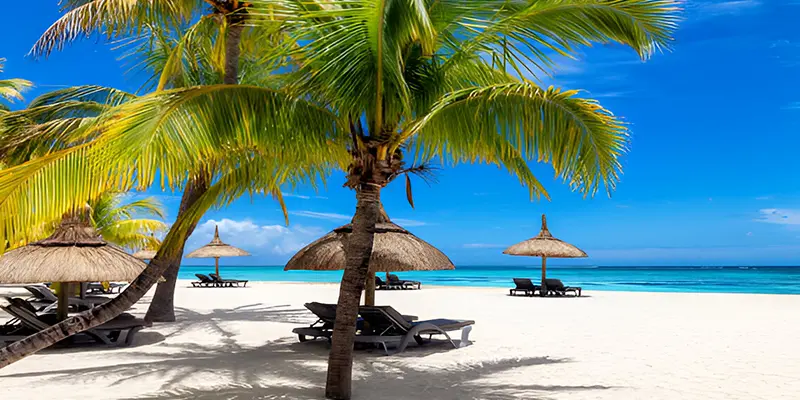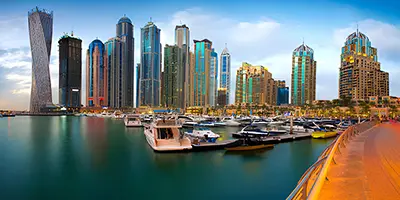
Best Time to Visit Mauritius: Complete Seasonal Guide
Mauritius, a beautiful paradise in the Indian Ocean, is a paradise that has year-round beauty; its beautiful beaches, greenery and vibrant culture attract millions of people to visit. But it’s worth it, and the time you choose to visit really can make all the difference. This detailed guide reveals the climate patterns, seasonal experiences and best months to visit Mauritius according to your interests, whether you want ideal beach weather, cultural celebrations or the best deals on travel. From sunny summer days to mild weather in the winter, we'll guide you through planning your ideal Mauritius holiday tour package with an authentic island experience.
Understanding Mauritius Climate
The climate is tropical, with two seasons: a warm and humid summer from November to April, and a relatively cool and dry winter from June to September. Situated in the Indian Ocean, the island has a generally subtropical climate with year round temperatures that average 22-28°c (72-82°F) in winter and 25-33°c (77-91°F) in summer along the coastal regions. The east coast can be windier, especially in winter, whereas the west and north coasts are more sheltered.
- Summer Season: November to April (warm and humid)
- Winter Season: May to October (cooler and drier)
- Cyclone Season: January to March (occasional tropical cyclones)
- Average Annual Rainfall: 1,500mm (59 inches), with more in the central highlands
- Microclimates: The island's topography creates several microclimates, with the central plateau being cooler and wetter than coastal regions
Best Months to Visit Mauritius
The ideal time to plan Mauritius holiday tour package depends on your preferences and planned activities. For most travelers, the periods from May to June and September to October offer the perfect balance of pleasant weather, lower humidity, and fewer tourists. These bear seasons give fabulous conditions for both shoreline exercises and investigating the island's characteristic attractions.
- For Beach Lovers: October to April (warmest water temperatures)
- For Outdoor Activities: May to October (lower humidity and rainfall)
- For Budget Travelers: May to June and September (better deals on accommodation)
- For Diving & Snorkeling: October to April (best visibility)
- For Hiking & Nature Exploration: May to October (cooler temperatures)
- Months to Avoid: January to March (potential cyclones and heavy rainfall)
Seasonal Breakdown
Each season in Mauritius offers unique experiences and considerations for travelers. Understanding the seasonal patterns will help you plan your visit to align with your preferences for weather, activities, and budget.
Summer (November to April)
The summer months bring warm temperatures, higher humidity, and occasional rainfall, typically in the form of short, heavy showers. This is the peak tourist season, especially around Christmas and New Year. The underwater visibility is excellent for diving and snorkeling, and the lush landscapes are at their most vibrant.
Winter (May to October)
Winter in Mauritius is mild and pleasant with lower humidity, cooler temperatures, and less rainfall. The trade winds can be stronger during this period, particularly on the east coast. This season is ideal for outdoor activities like hiking, golfing, and exploring the island's attractions. It's also a good time to spot dolphins and whales off the west coast.
Month-by-Month Guide to Mauritius
Each month in Mauritius offers a unique experience. Here's a detailed breakdown to help you plan your perfect trip:
January
January falls in the middle of summer and the wet season. Expect high temperatures (28-30°C) and humidity with occasional heavy but brief tropical showers. The sea is warm and perfect for swimming. This is cyclone season, so keep an eye on weather forecasts. Despite the rain risk, beaches on the west coast remain relatively sheltered.
- Average Temperature: 28-30°C
- Rainfall: High (cyclone season)
- Best For: Beach activities on the west coast, diving, snorkeling
- Events: New Year celebrations, Cavadee festival (Tamil festival)
February
February is the peak of summer and the wettest month. It's hot and humid with the highest risk of cyclones. However, rain typically comes in short bursts, leaving plenty of sunshine. The west coast remains drier than the east. Water visibility may be reduced for diving due to runoff.
- Average Temperature: 28-30°C
- Rainfall: Highest of the year (cyclone peak)
- Best For: West coast beaches, indoor activities, cultural experiences
- Events: Chinese New Year, Thaipoosam Cavadee
March
March marks the end of summer with gradually decreasing rainfall. Temperatures remain warm, and humidity starts to drop slightly. The cyclone risk diminishes toward the end of the month. It's a good transition month with fewer tourists and competitive prices.
- Average Temperature: 27-29°C
- Rainfall: Moderate to high (cyclone season ending)
- Best For: Hiking, exploring botanical gardens, beach activities
- Events: Maha Shivaratri, Independence Day (March 12)
April
April is a fantastic month to visit as the summer heat begins to subside. Rainfall decreases significantly, and humidity levels drop. The island is lush and green following the wet season. Water visibility improves for diving and snorkeling. This is considered a shoulder season with good deals on accommodation.
- Average Temperature: 26-28°C
- Rainfall: Moderate and decreasing
- Best For: Diving, snorkeling, hiking, outdoor activities
- Events: Ugadi (Telugu New Year), Easter celebrations
May
May marks the beginning of winter in Mauritius. Temperatures are pleasant during the day and cooler at night. Rainfall is minimal, making it an excellent time for outdoor activities. The trade winds pick up, creating ideal conditions for windsurfing and sailing, especially on the east coast. Tourist numbers are lower, resulting in better rates and less crowded attractions.
- Average Temperature: 24-26°C
- Rainfall: Low
- Best For: Windsurfing, sailing, hiking, golf
- Events: Labor Day (May 1)
June
June is one of the best months to visit Mauritius. The weather is cool and dry with plenty of sunshine. The sea remains warm enough for swimming, and underwater visibility is excellent for diving and snorkeling. This is peak whale-watching season off the west coast. It's an ideal time for exploring the island's natural attractions.
- Average Temperature: 22-24°C
- Rainfall: Very low
- Best For: Whale watching, diving, hiking, exploring
- Events: Ganga Snan (Hindu river festival)
July
July is the middle of winter and one of the driest months. Daytime temperatures are pleasant, but evenings can be cool. The trade winds are at their strongest, making it perfect for windsurfing and sailing. This is peak tourist season with European summer holidays, so book accommodations well in advance.
- Average Temperature: 21-23°C
- Rainfall: Very low
- Best For: Windsurfing, sailing, hiking, wildlife viewing
- Events: Ganesh Chaturthi (Hindu festival)
August
August continues the dry winter season with similar conditions to July. It's the coolest month of the year but still pleasant during the day. The strong trade winds persist, particularly on the east coast. This is high season with excellent conditions for outdoor activities but higher prices and more tourists.
- Average Temperature: 20-22°C
- Rainfall: Very low
- Best For: Water sports, hiking, exploring the island
- Events: Assumption of Mary (August 15)
September
September sees gradually warming temperatures as winter transitions to spring. The trade winds begin to ease, and rainfall remains minimal. Tourist numbers start to decrease after the European summer holidays. This is an excellent time to visit for good weather, fewer crowds, and better rates.
- Average Temperature: 21-24°C
- Rainfall: Low
- Best For: Beach activities, hiking, exploring
- Events: Ganesh Chaturthi celebrations
October
October brings warmer temperatures as summer approaches. Rainfall remains low, and humidity starts to increase slightly. The sea is calm and perfect for water activities. This is another excellent shoulder season month with good weather and reasonable prices before the high season begins.
- Average Temperature: 23-26°C
- Rainfall: Low to moderate
- Best For: Beach activities, water sports, exploring
- Events: Diwali (Festival of Lights)
November
November marks the beginning of summer with rising temperatures and humidity. Rainfall increases but typically comes in short afternoon showers. The sea is warm and calm, perfect for swimming and water sports. Tourist numbers begin to rise as the high season approaches.
- Average Temperature: 25-28°C
- Rainfall: Moderate and increasing
- Best For: Beach activities, water sports, exploring
- Events: Arrival of Indentured Laborers Day (November 2)
December
December is the start of the hot and humid summer season. Rainfall increases but typically comes in short, heavy bursts, leaving plenty of sunshine. The sea is warm and perfect for swimming. This is peak tourist season due to the holidays, so expect higher prices and more crowds. Book accommodations well in advance.
- Average Temperature: 27-30°C
- Rainfall: Moderate to high
- Best For: Beach activities, water sports, festive celebrations
- Events: Christmas and New Year celebrations
Best Time to Visit Mauritius: The Verdict
After analyzing the weather patterns and seasonal activities, the best time to visit Mauritius depends on your preferences:
- For perfect weather: May to October (winter) offers sunny days, low rainfall, and comfortable temperatures.
- For budget travelers: April, May, September, and October (shoulder seasons) provide excellent weather with lower prices and fewer tourists.
- For water sports: June to August is ideal for windsurfing and sailing due to stronger trade winds.
- For diving and snorkeling: October to April offers the best underwater visibility and warmer water temperatures.
- For whale watching: June to August is the peak season for spotting whales off the west coast.
- For avoiding crowds: May, June, September, and early December before the holiday rush.
Overall, May to early December represents the sweet spot for most travelers, offering a balance of good weather, reasonable prices, and manageable crowds. However, Mauritius is truly a year-round destination, with each season offering its own unique charm and experiences.
Tips for Planning Your Mauritius Trip
- Book in advance: Especially if traveling during peak season (December-January, July-August).
- Pack accordingly: Bring light clothing for summer months and a light jacket or sweater for winter evenings.
- Stay flexible: During cyclone season (January-March), be prepared for possible weather disruptions.
- Consider microclimates: The east coast is windier, while the west and north coasts are more sheltered.
- Monitor weather forecasts: Especially during the cyclone season, stay informed about potential weather changes.
- Travel insurance: Always recommended, particularly during cyclone season.


 ENG
ENG













